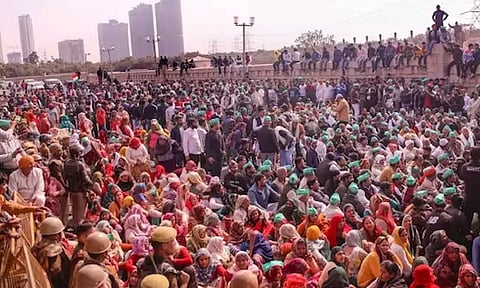

CHENNAI: For a government given to machismo, it’s amazing how quickly the BJP-led regime in New Delhi develops the shivers when farmers announce they’re coming. Over the weekend, police in Delhi, UP, Haryana and Rajasthan have been galvanised to thwart the Feb 13 Delhi Chalo march called by farmers from Punjab and Haryana under the banner of Kisan Mazdoor Morcha.
This is just one faction of the Kisan Samyukt Morcha that brought the government to its knees two years ago with a year-long protest against three pro-privatisation laws on agriculture. A blockade of highways nationwide has been announced by the national alliance of farmer unions on Feb. 16.
The prospect of farmers pitching tents on the highways, provisioning for a long siege, dancing, organising langars and supplying irresistible colour copy to the media mill is sending administrations into panic. Roads leading to Delhi are being barricaded, internet services have been suspended, petrol pumps have been ordered not to sell diesel to tractor drivers, and policemen in the border districts are practising tear gas drills.
Three ministers were rushed to Chandigarh to meet the leaders of the march to sweet talk them into giving the government more time to come good on the promises it made when it withdrew the three laws back in 2022. The main demand of the farmers remains that the MS Swaminathan principle of a fair minimum support price (1.5x the farmer’s cost) be enshrined as a law.
The BJP playbook in response to the farmers’ challenge is predictable: Impose internet silence, stop anyone driving a tractor or pickup truck, outlaw any assembly, flood the friendly media with Khalistan stories and infiltrate protest camps with provocateurs. While these are regulation tactics used by strongman governments, and are sufficient to outflank most protests, farmers are not easily cowed. Whatever the tactics, governments are always on a weak wicket against farmers. There’s no hardship they cannot endure, and they are past masters at living al fresco, and the rain is their friend!
Farmers have been the most potent opposition to the Modi regime in its 10 years, more effective than any opposition party. The fact that the only defeat suffered by Modi during his decadal rule was to farmers in 2022 tells us something about where the regime’s vulnerabilities lie.
Perhaps it’s only a coincidence that farmers should give us a hint towards the BJP’s Achilles heel just when it is dreaming of winning a massive majority in the coming Lok Sabha elections. But there’s recent history to support the notion that large majorities count nothing when faced with angry farmers.
In 1984, the Congress under Rajiv Gandhi won 414 Lok Sabha seats but the nation’s enchantment with him was broken in 1988 when half a million farmers hunkered down in the heart of the capital, demanding a write-off of power bills. Churlishly, the proto-neoliberal coterie around the then PM responded by using schoolboy pranks, including playing Bruce Springsteen songs on loudspeakers, to make them leave. The protests only grew worse, and it was all downhill thereafter for the majority regime.
The India Shining regime of Vajpayee-Advani too came a cropper at the hands of farmers in 2004. After enduring a sequence of crippling droughts, rural India was put off by the regime’s puffery about expressways and malls, and voted with its feet in the elections. The farmer is not a good foe to have and cannot be won over with a Bharat Ratna.